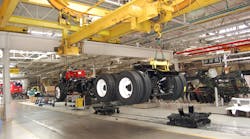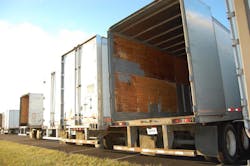Stifel Capital Markets is raising its production estimates for Class 8 and medium-duty trucks, as well as for trailers, this year based on improvements in the outlook for the U.S. freight economy.
Michael Baudendistel, vice president of Stifel’s transportation & logistics research group, said in research note this week that “some combination of lower tax rates, lower regulations, improved domestic manufacturing, and pro-energy policy” will “help freight volumes,” which he expects will translate into orders in late 2017 for increased production starting in 2018.
Stifel’s upward revisions of its estimates are as follows:
- Production of Class 8 trucks in 2018 is being hiked to 230,000 units from 210,000, with production in 2019 rising to 265,000 units from a previous estimate of 230,000 units. However, Stifel is maintaining its current 2017 Class 8 production prediction at 200,000 units, which is down 12% from 228,000 units in 2016.
- Stifel is “moderately increasing” its medium-duty truck production estimates for 2017 from 230,000 to 235,000 units; for 2018 from 240,000 to 245,000 units; and for 2019 and increase from 245,000 to 250,000 units. Baudendistel noted that while those increases also reflect “an improved economic outlook” for the U.S., they are “more modest given the less volatile nature of medium-duty production.”
- Where trailers are concerned, Stifel is now projecting production increases for 2017 from 235,000 to 250,000 units, while for 2018 it will jump from 225,000 to 240,00 units. For 2019, production will rise from 240,000 to 255,000 units.
The industry-wide trailer order backlog remained at “historically high levels” at the end of 2016, he said, increasing 13% sequentially in December, even though the backlog is down 32% compared to 2015 year-end levels. “At 127,000 units, the year-end backlog represents about six months of production at anticipated 2017 production rates, which is higher than the historical average,” Baudendistel pointed out.
Where Class 8 trucks are concerned, he noted inventories remain “slightly elevated” despite having been drawn down significantly from their highs in late 2015.Yet he expects future demand for highway tractors will be boosted by the enforcement of the electronic logging device (ELD) mandate, which Stifel predicts could potentially take 3% to 5% of capacity out of the industry, mainly from small fleets and owner-operators. As a result, that loss of capacity offers the potential to improve the profitability levels of large fleets and thus, in turn, could translate into equipment investment.
In addition, as the industry approaches Phase 2 of the greenhouse gas (GHG) standards in 2021, Baudendistel said “the potential exists for a pre-buy in 2019 and 2020; not an immediate catalyst, but one that we can envision causing a sharp peak toward the end of the decade.”
The same potential for “a moderate, but significant, pre-buy” exists for trailers this year, he noted, ahead of the imposition of the 2018 Phase 2 GHG mandates. “Our industry production estimates assume a 10,000 unit pull-forward from 2018 to 2017 as a result of any pre-buy,” Baudendistel pointed out.
Both of those GHG-influenced predictions, however, come with “the caveat” that the Trump administration does not spark a “scaling back” of the GHG standards, he stressed.
Baudendistel added that Stifel’s estimates assume that the Broader U.S. economy avoids a recession during the next several years and that gross domestic product (GDP) growth remains at or above 2.5%.
“If a recession were to occur, Class 8 production could decline to the 150,000-175,000 unit range,” he warned.




